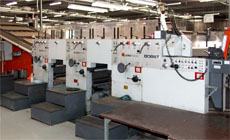Flexo industryIn the printing industry various techniques are used. The best know are offset, flexo and gravure printing. In the flexo printing industry anilox rolls are used to apply the ink. Besides ink anilox rolls are also used to apply coating or glue on paper or other materials. Anilox rolls are an essential part of the flexo print presses. The anilox roll is a steel roll coated with a ceramic layer which has been ground and polished to a smooth finish. The surface of an anilox roll has open cells, which are made by mechanical or laser engraving techniques. These cells determine the volume of ink which is transferred from roll to the printing plate in a flexo press. The ink volume of an anilox roll varies. To see these open cells you must use a microscope. If you compare all printing techniques in various markets flexo print represents 15 to 20 percent. Within the packaging industry flexo print represents more than 50% in North America and 35% in Europe. In Asia a gravure culture exists, so flexo print has a lesser share in that market. Industry growth areasIn recent years flexo print has shown rapid development, yielding a surprisingly high quality standard. Flexo printing is the fastest growing printing technique today. Flexo print used to be suitable only for relatively simple print jobs. Nowadays almost every print job can be done with flexo. A full range of quality is possible: from simple packaging bags to fine screen labels in eight or more colors. Flexo print facilitates the use of almost every available substrate. As distinct from other techniques, flexo print can be used on ultra thin synthetic foil. Even heavy absorbing paper, for instance napkins, can be printed without problem. Unmanageable corrugated cardboard printed in four color screens has become common practice. Flexo print is very suitable for production of packaging in one process. Synthetic foils can be printed immediately after extrusion. Corrugated cardboard can be shivered (corrugated and laminated), printed, folded, punched and pasted on one single continuous assembly line. Similarly self adhesive labels are printed on small trace machines, varnished, provided with a golden foil and punched in a single continuous process. The recent revolution in pre-press has also influenced flexo print. Digital imaging plays a more dominant role. This means that existing images can be used in flexo print, which results in the same presentation in packaging, advertising and displays. Small or large circulation, flexo has become an attractive print technique. It is simple to implement temporary alterations initiated by promotional actions like special price offers. Even several alterations within one circulation is possible with flexo print. |

Flexo printer Slotter Kappa van Dam b.v.
Bobst Flexo printer units
|
Reset Password
 Please wait ...
Please wait ...










